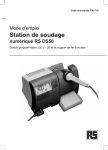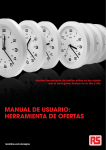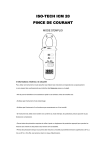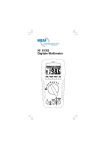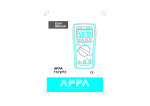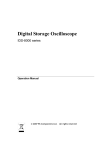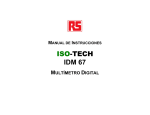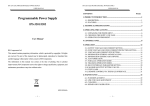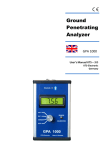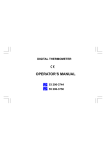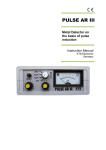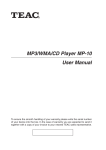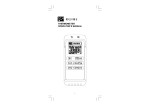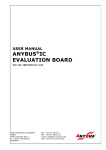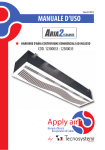Download Iso-tech IDM61-62T Instruction Manual
Transcript
IDM 61/62T Digital Multimeter Instruction Manual # Safety Information Read and understand this Instruction Manual completely before using this instrument. Failure to observe the warnings and cautions in this Instruction Manual may result in injury or death, or damage to the instrument and other equipment or property. If this instrument is used in a manner not specified in these instructions, the protection provided by the instrument may be impaired. • • • • • • • • • • • • • • # WARNING Examine the instrument and probes before use. Do not use the instrument if it is wet or damaged. When using test leads or probes, keep your fingers behind the finger guards. Remove the test lead from the instrument before opening the battery cover or instrument case. Always use the correct terminals, switch position and range for measurements. Never attempt a voltage measurement with the test leads inserted into the A input terminals. Verify the instrument is operating correctly by measuring a known voltage before use. If in doubt, have the instrument serviced. Do not apply more than the rated voltage, as marked on the instrument, between terminals or between any terminal and earth ground. Do not attempt a current measurement when the open-circuit voltage is above the fuse protection rating. Only replace a blown fuse with the correct type and rating as specified in this Instruction Manual. Use caution when measuring voltages above 30 Vac rms or 60 Vdc. These voltages pose a shock hazard. To avoid incorrect readings that can lead to electric shock, replace the battery as soon as low battery indicator appears in the display. Disconnect the circuit power and discharge all highvoltage capacitors before making resistance, current, continuity, diode or capacitance measurements. Do not use the instrument in a Hazardous Area or around explosive gasses or vapours. Wear suitable Personal Protective Equipment when working around or near hazardous Live conductors which could be accessible. # Caution ․ Disconnect the test leads from the test points before changing the position of the function rotary switch. ․ Never connect the instrument to a source of voltage with the function rotary switch in Ω/ :;/∋ %A /</Hz position. ․ If possible, do not work alone, so assistance can be given if required. ․ Do not expose the instrument to extremes of temperature or high humidity. ․ Never set the instrument to the ∋ %A function to measure the voltage of a power supply circuit, as it may result in damage to the instrument and the equipment under test. The following symbols may appear on the instrument and in this Instruction Manual: ∀ Risk of electric shock # ∋ Refer to Instruction Manual 1 Equipment protected throughout by double or reinforced insulation Direct Current (dc) Battery & Fuse ) % Earth 6 Conforms to applicable EU directives Alternating Current (ac) Maintenance Do not attempt to repair this Instrument. It contains no user-serviceable parts. Repair or servicing should only be performed by qualified personnel. This instrument should be calibrated yearly, or more frequently if used in harsh conditions or if it is suspected of being inaccurate. For calibration and repair contact RS Components - the address is given at the end of these instructions. Cleaning Periodically wipe the case with a damp cloth and detergent. Do not use abrasives or solvents. Measuring AC/DC Voltage and Frequency Continuity and Diode Test Bad Diode Red Black Red Black Good Diode Red Black Red Black Resistance and Capacitance Measurement (Capacitance for 62T only) Note– To improve the measurement accuracy of a small value capacitor, record the reading with the test leads open circuit, then substract the residual capacitance of the Instrument and leads from the final measurement. CUNKNOWN = CMEASUREMENT - CRESIDUAL MIN MAX Record (For 62T only) Measuring DC / AC Current (For 62T only) Temperature °C , °F Display Hold Manual Ranging and Auto Ranging Auto Power-off (Battery Saver) 10 min Disable Auto Power-off Non-Contact Voltage Sensing (VoltSense) NCV 1. The VoltSense function will operate irrespective of the position of the function rotary switch, including the OFF position. 2. Remove the test leads from the instrument as they are not used for the VoltSense test. 3. Press and hold the VoltSense button. The LCD display will go blank, a tone will sound and the red LED will illuminate momentarily to confirm the instrument is operational. 4. Hold the Volt sense button down and move the instrument over the area where detection is required. The buzzer will sound and the LED will illuminate when a live conductor is detected. Release the VoltSense button to return to normal operation. Fuse Replacement (For 62T only) ∀ Warning Disconnect the test leads from the circuit and the instrument before removing the rear cover. # Caution Use only a replacement fuse of the type and rating given in the specifications. Refer to the following figure to replace the fuse: Battery Replacement When the low battery indicator " " appears on the LCD, replace the batteries with the type given in the specifications. ∀ WARNING Disconnect the test leads from the circuit and the instrument before removing the battery cover. Refer to the following figure to replace the batteries: Specifications General Specifications Display: 2000 counts. Polarity Indication: Automatic, positive implied, negative indicated. Overrange Indication: “OL” or “-OL”. Battery Life: 250 hours approx with Alkaline cells. Low Battery Indication: “ ” is displayed when the battery voltage drops below the minimum operating voltage. Auto Power-off: Approx 10 minutes after last operation. Storage Temperature: -20 to 60°C (-4°F to 140°F) @ 0 to 80% R.H. with the battery removed from the instrument. Operating environmentent: Non-condensating, ≦ 10°C (50°F); 11 to 30°C (51.8°F to 86°F) @ ≦80% R.H; 31 to 40°C (87.8°F to 104°F) @ ≦75% R.H; 41 to 50°C (105.8°F to 122°F) @ ≦45% R.H. Measurement Category (Installation Category) per IEC 61010-1:2001: V/Ω: CAT.III. 600V, CAT.II. 1000V. A: CAT.III. 600V (for 62T only) Pollution Degree 2 Measurement Category l is for measurements performed on circuits not directly connected to mains. Examples include: Measurements on battery powered equipment and specially protected (internal) mains-derived circuits. Measurement Category ll is for measurements on circuits directly connected to the low voltage installation. Examples include: Household appliances, portable tools and similar equipment. Measurement Category lll is for measurements performed in the building installation. Examples include measurements on distribution boards, junction boxes, socket-outlets and wiring and cables in the fixed installation. Measurement Category lV is for measurements performed at the source of the low-voltage installation. Examples include measurements on primary overcurrent protection devices and electricity meters. Temperature Coefficient: 0.27 x Spec. Accy / °C <18°C or >28°C; (0.15 x Spec.Accy / °F,< 64.4°F or > 82.4°F). Power Requirements: Qty. 2 x 1.5V Alkaline type AA batteries. Fuse (For 62T only): 10mmx38 mm 10Amp 600V ac/dc HBC, Littlefuse KLKD10 or equivalent. Dimensions (W x H x D): 74mm x 156mm x 44mm Accessories: Battery (installed), Test leads and user manual. Measurement rate: Sampling rate 2 times per second nominal. Altitude: 6561.7 ft (2000m) Safety: Complies with EN61010-1:2001, UL61010-1:2001 and IEC 61010-1:2001. Weight: (320g) including battery. Electrical Specifications Accuracy is ±(% reading + number of digits) at 23°C ± 5°C < 80%RH. DC / AC Volts Range AC Accuracy 200.0mV * Unspecified 2.000V * ±(1.5%+5dgt) 20.00V ~ 200.0V * ±(1.5%+5dgt) 50Hz ~ 300Hz 50Hz ~ 500Hz * 750V AC / 1000V DC DC Accuracy : ±(0.5% + 2dgt) Over voltage protection : 1000V DC or 750 V ACrms. Input Impedance : 10MΩ // less than 100pF. * CMRR / NMRR : (Common Mode Rejection Ratio) (Normal Mode Rejection Ratio) VAC : CMRR > 60dB at DC, 50Hz / 60Hz VDC : CMRR > 100dB at DC, 50Hz / 60Hz NMRR > 50dB at DC, 50Hz / 60Hz AC Conversion Type : Average sensing rms indication. AC conversions are ac-coupled, true rms responding, calibrated to the sine wave input. * The minimum LCD reading is 1400 count in Auto Ranging Mode. Crest Factor: C.F. = Peak / Rms + 1.5% addition error for C.F. from 1.4 to 3 + 3% addition error for C.F. from 3 to 4 DC / AC Current Range 2.000A (For 62T only) DC Accuracy ±(1.0% + 3 dgt) AC Accuracy Voltage Burden ±(1.5% + 5 dgt) 50Hz ~ 2V max 500Hz * 10.00A ** Overload Protection: A input : 10A (500V) fast blow fuse * AC Conversion Type : Conversion type and additional specification are same as DC/AC Voltage. ** Ampere Testing Duty Ratio Table Ampere Testing Time Rest Time 10A 4min 10min 9A 5min 10min 8A 7min 10min 7A 10min 10min 6A Continuous N/A Accuracy Voltage Burden Resistance Range 200.0 ~ 200.0KΩ ±(0.7% + 3 dgt) 2V max ** 2.000MΩ ** ±(1.0% + 3 dgt) 20.00MΩ * ±(1.5% + 3 dgt) Open circuit Voltage: -1.3V approx. * <100 dgt rolling. * * The minimum LCD reading is 1400 count in Auto-ranging mode. Diode Check and Continuity Range Resolution Accuracy : 10 mV ±(1.5% + 5 dgt)* * For 0.4V ~ 0.8V Max.Test Current : 1.5mA Max. Open Circuit Voltage : 2V Overload Protection : 600V rms. Frequency (For 62T only) Range 2000Hz ~200.0KHz 2.000MHz ~ 20.00MHz Sensitivity Accuracy >1.5 Vac rms, <5 Frequency : 0.01%±1digit Vac rms >2 Vac rms, <5 Vac rms Overload Protection: 600V rms. Minimum pulse width: >25 ns Duty cycle limits: >30% and <70% Capacitance (For 62T only) Range Accuracy Overload Protection 2.000nF ~ 200.0µF ±(1.9% + 8 dgt) 600V rms 2.000mF * * < 10 dgt of reading rolling. Temperature (°C ) (For 62T only) Temperature Accuracy Overload Protection -20°C ~ 0°C ±(2% + 4°C ) 600V rms 1°C ~ 100°C ±(1% + 3°C ) 101°C ~ 500°C ±(2% + 3°C ) 501°C ~ 800°C ±(3% + 2°C ) Temperature (°F ) (For 62T only) Accuracy Overload Protection -4°F ~ 32°F ±(2% + 8°F) 600V rms 33°F ~ 212°F ±(1% + 6°F) 213°F ~ 932°F ±(2% + 6°F) 933°F ~ 1472°F ±(3% + 4°F) Temperature Limited Warranty This instrument is warranted to the original purchaser against defects in material and workmanship for 1 year from the date of purchase. During this warranty period, RS Components will, at its option, replace or repair the defective unit, subject to verification of the defect or malfunction. This warranty does not cover disposable batteries, or damage from abuse, neglect, accident, unauthorized repair, alteration, contamination, or abnormal conditions of operation or handling. Any implied warranties arising out of the sale of this product, including but not limited to implied warranties of merchantability and fitness for a particular purpose, are limited to the above. RS Components shall not be liable for loss of use of the instrument or other incidental or consequential damages, expenses, or economic loss, or for any claim or claims for such damage, expense or economic loss. Some states or countries laws vary, so the above limitations or exclusions may not apply to you. For full terms and conditions, refer to the current RS Catalogue. United Kingdom: RS Components UK PO Box 99, Corby, Northants., NN17 9RS Tel: 01536 201234 Fax: 01536 405678 http://rswww.com Deutschland: RS Components GmbH Hessenring 13b 64546 Mörfelden-Walldorf Telefon: 06105/401-0 Fax: 06105/401-100 http://www.rsonline.de España: RS Amidata SA Parque Empresarial Urbis Center Avda de Europa 19 – Edificio 3 28224 Pozuelo de Alarcón Madrid España Tel: (34) 902 10 07 11 http://www.amidata.es Italia: RS Components SpA Via M.V. De Vizzi 93/95 20099 Cinisello Balsamo (Mi) tel: +39 02 66058.1 fax: +39 02 66058.051 http://www.rs-components.it Francais: Radiospares Composants SNC Rue Norman King BP453 F-60031 Beauvais Cedex France Tel: (33) 3 44 10 1500 Fax: (33) 3 44 10 1507 http://www.radiospares.fr

















